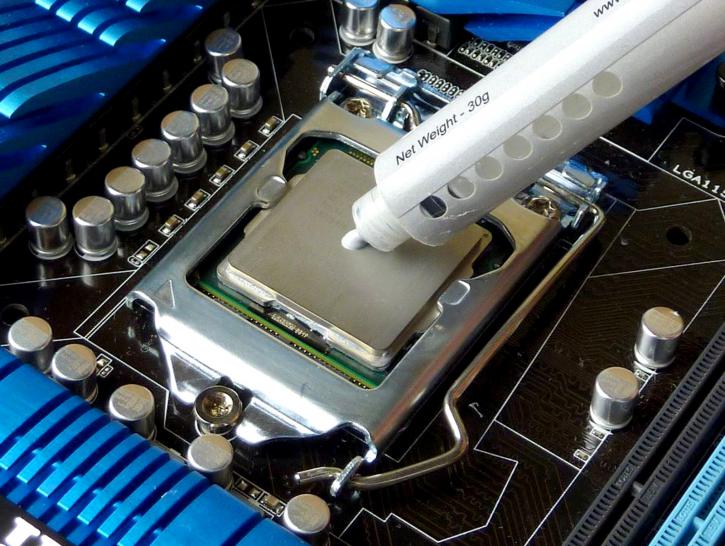Basic information
One 101
Thermal paste is essential in lowering the temperature of your CPU. Your CPU will most of the time heat up while performing demanding tasks like gaming and video editing. When it becomes too hot, it is likely to throttle down, affecting your computer's performance. Applying thermal paste will go a long way in alleviating this problem besides adding some time to your computer's lifespan. You should consider investing in a thermal paste if you are a serious computer user. Obviously, a good cooler is mandatory as well. Thermal paste sits as a layer in between the processor and the heat sink. Metal isn't typically perfectly flat. No matter how bland it may look to the naked eye, there is always bumps and grooves and tiny holes and divots. These holes and divots and bumps trap air when another piece of metal is pressed against it. This is an excellent insulator of heat. As a result, the heat transfer from your AMD or Intel processor to the heat sink isn't optimal and often can overheat and harm your system. Thermal paste resolves this issue. Not only is it engineered to be more thermally conductive (meaning it helps to transfer heat from one area to another), but since it's in a liquid form, it can press down and get in between all the little nooks and crannies that usually trap air when the thermal paste isn't used.
There are three common types of thermal paste: metal-based, ceramic, and silicon-based
Metal-Based Thermal Paste
Metal-based thermal pastes are typically made of metals such as aluminum or silver. Since they are metal, they have the highest thermal conductivity of all the different types of thermal grease and, therefore, offer the lowest temperatures.
However, the downside of metal-based thermal compounds is that because they are metal-based, that also means that they conduct electricity. The danger of this is that if you were to accidentally apply too much metal-based thermal grease on the back of your processor and it spilled out onto the circuits of your motherboards, there is the potential that those circuits will short and your motherboard will be damaged as a result.
Ceramic Thermal Paste
If you don't want the potential dangers that come with metal-based thermal pastes, your next best option is a ceramic-based thermal paste. Unlike metal-based thermal compounds, ceramic thermal pastes do not conduct electricity and, therefore, do not pose the threat of damaging your motherboard's circuits if you spill it. However, while ceramic-based thermal pastes do an adequate job of transferring heat from your processor to your heat sink, they do not perform quite as well as metal-based compounds. Still, the difference in cooling between metal and ceramic-based compounds is typically less than a few degrees.
Carbon-Based Thermal Paste
Like ceramic thermal pastes, carbon-based thermal compounds do not conduct electricity and, therefore, do not pose the threat of damaging your motherboard. And, like metal-based thermal greases, they offer better cooling than ceramic-based thermal pastes. The most popular carbon-based thermal paste outperforms one of the more popular metal-based thermal compounds. So, if you're looking for the best of both worlds (performance and safety), you might want to consider a carbon-based thermal paste.
Below you can find the table with the contestants and their main characteristics.
- The thermal conductivity of a material is a measure of its ability to conduct heat. Heat transfer occurs at a lower rate in low thermal conductivity materials than in materials of high thermal conductivity. For instance, metals typically have high thermal conductivity and are very efficient at conducting heat. You can find here the W/mK unit.
- Density, or more precisely, the volumetric mass density, of a substance is its mass per unit volume (here g per cm3)
- Electrically conductive - The particles of the conductive component are in contact with each other and, in this way, make electric current possible. The conductive part can be silver, nickel, copper or graphite. Other conductive materials are possible but unusual.
- Ease of use – speaks for itself
|
Name |
Thermal conductivity |
Density |
Electrically conductive |
Ease of use |
Comments |
|
13,4 W/mK |
n/a |
No |
Easy |
|
|
|
n/a |
3.2 g/cm³ |
No |
Medium |
|
|
|
9,3 W/mK |
2.6 g/cm³ |
No |
Hard |
Seems to thick |
|
|
8,3 W/mK |
2.6 g/cm³ |
No |
Medium |
|
|
|
1,6 W/mK |
3 g/cm³ |
No |
Hard |
sticky |
|
|
8.5 W/mK |
2.6 g/cm³ |
No |
Medium |
|
|
|
62.5 W/mK |
n/a |
No |
Easy |
|
|
|
11,8 W/mK |
2.6 g/cm³ |
No |
Medium |
|
|
|
14.2 W/mK |
3.76 g/cm³ |
No |
Medium |
|
|
|
9.1 W/mK |
2.7 g/cm³ |
No |
Easy |
|
And here's the list sorted by Thermal conductivity given by the manufacturers:
|
Name |
Thermal conductivity |
|
Thermal Grizzly Carbonaut |
62.5 W/mK |
|
Thermal Grizzly Kryonaut Extreme |
14.2 W/mK |
|
Alpenföhn Permafrost 2 |
13,4 W/mK |
|
Thermal Grizzly Hydronaut |
11,8 W/mK |
|
Cryorig CP5 |
9,3 W/mK |
|
Zalman STC9 |
9.1 W/mK |
|
Thermal Grizzly Aeronaut |
8.5 W/mK |
|
Cryorig CP7 |
8,3 W/mK |
|
EVGA Frostbite 2 Thermal Grease |
1,6 W/mK |
|
Arctic Cooling MX-5 |
n/a |
Let's head to the presentation of the contestants on the following pages.


